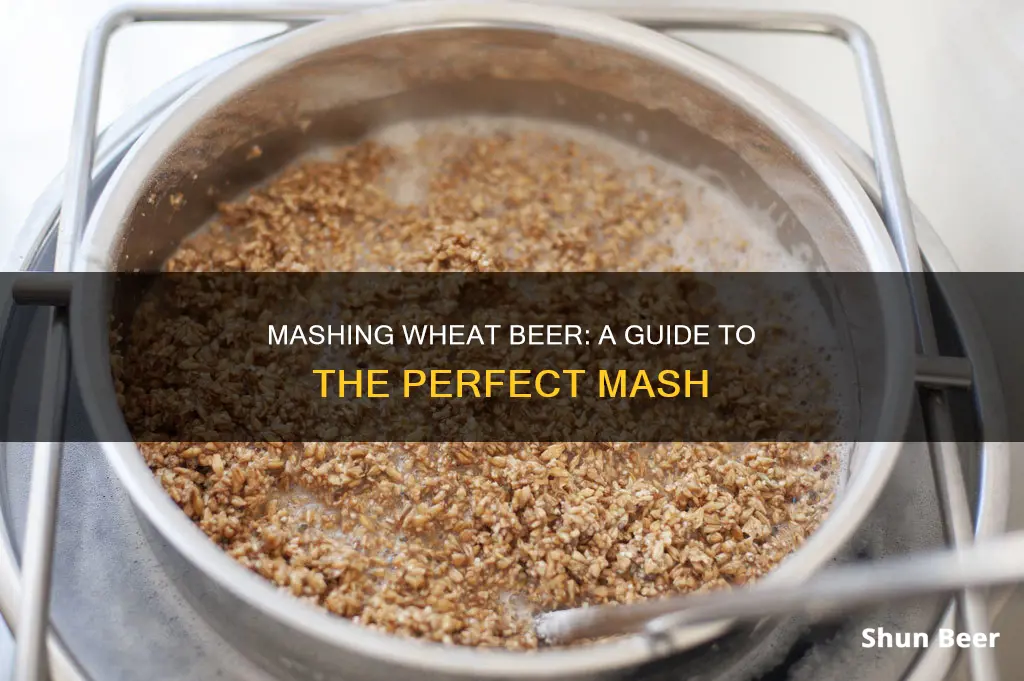
Wheat beers are a blend of wheat and barley, with wheat making up 30-70% of the total. Wheat beers are often hazy with proteins and offer a distinct contrast to the brightly filtered industrial brews. Wheat beers are also lighter in colour and contribute less flavour than barley, making them a great summer brew and a smooth transition to craft beers for those who usually drink Bud or Miller.
Wheat beers are not necessarily difficult to make, but there are some key considerations to keep in mind. Wheat malt lacks the thick barley husk, so it absorbs water more quickly and steeping times are shorter. Wheat malt is also relatively less modified than barley malt, and kilning is done at lower temperatures.
To avoid a stuck mash, try to minimise the amount of flour and make wheat malt the last addition to the mash tun so that malts with husks rest on the false bottom or lautering screen. Mixing rice hulls into the grain bed can also help to substitute for the missing barley husks.
| Characteristics | Values |
|---|---|
| Wheat to Barley Ratio | 30-70% wheat |
| Yeast | White Labs 300 Hefeweizen, Wyeast 3068 Weihenstephan |
| Fermentation Temperature | 65°F/18°C for a 68°F/20°C fermentation |
| Hop Character | Low hops bitterness and flavor |
| Hop Variety | Noble variety with spicy, herbal flavors |
| Hop Quantity | 10-15 BUs, early in the kettle, with very low aroma |
| Mash pH Range | 5.2 to 5.6 |
| Rice Hulls Quantity | 1 lb (0.45 kg) in the mash for a 5-gallon (19-liter) batch |
| Wheat Types | Hard, soft, red, white, spring, winter |
What You'll Learn
- Choose the right yeast strain to develop your desired flavour profile
- Select the type of wheat: hard winter red wheat for a full, grainy taste or white summer wheat for a light, delicate flavour
- Keep hops bitterness and flavour low so that the wheat and yeast characters can shine
- Avoid a stuck mash by minimising the amount of flour and making wheat malt the last addition to the mash tun
- Ferment at the right temperature to generate the flavours you want in your beer

Choose the right yeast strain to develop your desired flavour profile
When it comes to wheat beer, the yeast you choose will have a significant impact on the flavour profile of your brew. Wheat beer is typically fermented with ale yeast, which works best at room temperature (18-22°C or 64-71°F) and produces slightly fruity notes.
There are a few key factors to consider when selecting the right yeast strain for your desired flavour profile:
Attenuation
Attenuation refers to the percentage of available sugars in the wort that the yeast ferments. It is typically described as low (72% and lower), medium (73-77%), or high (78% and up). A high-attenuating yeast will result in a drier finish, while a low-attenuating yeast will leave more sugars unfermented, resulting in a sweeter, fuller-bodied beer.
Flocculation
Flocculation is the tendency of yeast cells to clump together and settle at the bottom of the fermenter. Wheat beer strains typically have low flocculation, which contributes to the traditional cloudiness of wheat beers. However, if you desire a clearer beer, you may want to choose a yeast strain with higher flocculation properties.
Fermentation Temperature
Ale yeast strains, including those used for wheat beer, prefer warmer temperatures (18-22°C or 64-71°F). Fermenting at the optimal temperature will help to avoid off-flavours and ensure the desired flavour compounds are produced.
Alcohol Tolerance
Yeast strains have varying levels of alcohol tolerance, and this can impact the final alcohol content of your beer. If you are aiming for a higher alcohol content, choose a yeast strain with a higher alcohol tolerance.
Sensory Profile
The sensory profile of a yeast strain refers to the flavours and aromas it produces, and it is influenced by factors such as temperature, pitch rate, and oxygen levels. Wheat beer strains often produce phenolic flavours, such as clove and banana, which can be desirable in the right quantities.
When choosing a yeast strain, it is important to consider the specific qualities you want in your beer, such as flavour characteristics, residual sweetness, and mouthfeel. Experimentation is also key, so don't be afraid to try different yeast strains to find the perfect match for your wheat beer.
Asahi Beer: Wheat-Free or Not?
You may want to see also

Select the type of wheat: hard winter red wheat for a full, grainy taste or white summer wheat for a light, delicate flavour
Wheat beer is a versatile beverage with a long history, dating back to the Babylonians, who are believed to have made wheat beer for 400 years. Today, wheat beer is enjoyed worldwide, with notable varieties such as the German Weissbiers, Hefeweizens, and Weissbocks.
When selecting wheat for brewing, the two primary options are hard winter red wheat and white summer wheat. Each type of wheat lends distinct characteristics to the final product. Let's explore the unique attributes of these wheat varieties and how they contribute to the flavour and experience of wheat beer.
Hard winter red wheat is characterised by its high protein content, which is typically associated with bread flour. This variety of wheat will impart a full, grainy taste to your beer. While it can be challenging to work with due to its lack of husk, careful techniques such as cereal or turbid mashing can be employed to utilise its unique qualities. Hard winter red wheat is ideal for lambics or wit beers, adding a distinct haze to the finished product.
On the other hand, white summer wheat offers a softer and lower protein content, often milled into cake flour. This variety will lend a light and delicate flavour to your wheat beer. White wheat was traditionally used in witbiers, but red wheat can also be a suitable alternative.
When brewing with wheat, it is essential to manage its protein content to achieve the desired clarity and flavour. Wheat is known for contributing to a thick, long-lasting head, a signature characteristic of wheat beers. To enhance this trait, brewers often add a portion of wheat malt to their barley-based beers.
In summary, the selection of wheat plays a crucial role in shaping the character and flavour profile of wheat beer. Hard winter red wheat adds a robust, grainy taste, while white summer wheat contributes a softer, more delicate note to the brew. By understanding the unique attributes of these wheat varieties, brewers can create beers that range from full-bodied and grainy to light and delicate, catering to a diverse range of tastes and preferences.
Wheat-Free Refreshment: 805 Beer's Unique Blend
You may want to see also

Keep hops bitterness and flavour low so that the wheat and yeast characters can shine
Wheat beers are known for their mild flavour and little to no hop flavour or bitterness. This allows the wheat and yeast characters to be the star of the show.
To ensure the hops don't overpower the other flavours, it's important to keep the bitterness low. This can be achieved by using hops that are low in alpha acids, as these hops will have a harder time adding bitterness to the beer. Aroma hops, for example, typically have an alpha-acid percentage of less than 10%.
Additionally, the timing of when the hops are added during the brewing process will also impact the bitterness and flavour. Aroma hops should be added late in the boil, during the last 10 to 15 minutes, or in a dry hop after fermentation has begun. This ensures that the delicate hop flavours and aromas are not boiled off.
When creating a wheat beer, the type of yeast used is also important to let the wheat character shine. A neutral ale yeast is often recommended as it doesn't impart strong yeast-derived flavours. Instead, it allows the hops and malt flavours to take centre stage.
Finally, the wheat-to-barley ratio in the grain bill will also impact the overall flavour of the beer. Wheat malt contributes to the body and mouthfeel of the beer, so having a higher percentage of wheat malt will emphasise these characteristics. A common ratio for American Wheat Beer is a balanced approach with a 50/50 split of wheat malt to barley malt, but this can vary from 25% to 70% wheat malt.
By keeping the hops bitterness and flavour low, and carefully selecting the yeast and grain bill, brewers can create delicious wheat beers that showcase the unique qualities of wheat and yeast.
Wheat Beer: What's the Deal?
You may want to see also

Avoid a stuck mash by minimising the amount of flour and making wheat malt the last addition to the mash tun
Wheat malt lacks husks, which can make it difficult to brew with. One of the most common issues brewers face when working with wheat malt is a stuck mash. This occurs when the mash clogs the wort outlets, causing the sparge to take a long time.
To avoid a stuck mash, it is important to minimise the amount of flour in the grist. This can be done by ensuring that the malted grains are not crushed too finely. Wheat malt should also be the last addition to the mash tun, with the other malts added first to create a layer of husks on the false bottom or lautering screen. This will help to ensure that the wort can flow freely.
In addition to these steps, it is recommended to add rice hulls to the mash. Rice hulls will aid in maintaining porosity without affecting the flavour, colour, or gravity of the beer. For a 5-gallon (19-litre) batch, add 1 pound (0.45 kg) of rice hulls to the mash.
By following these steps, brewers can avoid a stuck mash and successfully create a wheat beer with a smooth flavour and a thick, long-lasting head.
Blue Moon Honey Wheat Beer: Strong, Sweet, and Refreshing
You may want to see also

Ferment at the right temperature to generate the flavours you want in your beer
Fermentation temperature has a significant impact on the final flavour of your beer. The ideal temperature range for most beers is between 60 and 70 degrees Fahrenheit. Fermenting at the lower end of this range will help to preserve the hoppy flavour of your beer, whereas the higher end will ensure your beer doesn't develop excessive acidity.
If you're brewing a lager, you'll want to ferment at an even cooler temperature of 45-55 degrees Fahrenheit. This will give your beer a clean, crisp flavour.
On the other hand, if you're brewing a malt wine, you'll want to ferment at a higher temperature. This will promote the growth of specific types of yeast that produce fruity or spicy flavours.
It's important to maintain a consistent fermentation temperature to avoid problems such as stressed yeast cells, which can stop the fermentation process and even kill the yeast.
You can also adjust the fermentation temperature to fine-tune the flavour of your beer. For example, increasing the temperature will result in more alcohol being produced, as well as higher levels of esters and fusel alcohols. Conversely, decreasing the temperature will slow down the fermentation process and reduce the amount of alcohol produced.
So, when brewing wheat beer, keep in mind that the fermentation temperature will affect the final flavour. Experiment with different temperatures to find the ideal range for your desired flavour profile.
Landshark Beer: Is It Safe for Wheat Allergies?
You may want to see also
Frequently asked questions
The wheat portion in a wheat beer is anywhere from 30-70% of the total, with the barley making up the rest. A 50-50 wheat-barley ratio is a common choice.
Wheat malt lacks husks, which can lead to stuck mashes. To avoid this, you can add rice hulls to the mash, use a coarser grind for your wheat malt, or adjust the mill to grind your wheat malt more coarsely than the barley malt.
You can choose between "hard" and "soft" wheat, which refers to the kernel's texture. Hard wheat requires more force to disintegrate and has a coarser particle size, while soft wheat is finer and used for cakes and cookies. You can also choose between "red" and "white" wheat, which refers to the colour of the seed coat.







